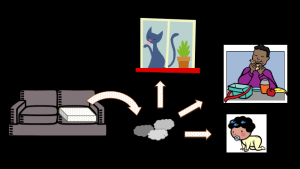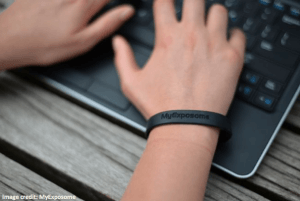Monitoring chemicals in our environment with wristbands
May 18, 2016
Whether to show support for a cause or track daily activity, wristbands and tracking bracelets have become a trendy modern accessory.
Why Monitor?
Six Classes and other chemicals of concern are present in everyday products and materials that surround us at home, work, and elsewhere. They can end up in dust or air and can get into our bodies through ingestion, breathing, and direct skin contact.

To learn how these chemicals impact our health, it’s important to know which ones are in our products, what chemicals we come into contact with in our daily lives, and also which could end up in our bodies.
Scientists use a number of methods to understand what chemicals people are exposed to in daily life. The methods range from monitoring the environments we live in to measuring chemicals in our bodies through blood and urine tests (called “biomonitoring”). It is useful to have information from multiple methods in order to determine how people are being exposed to certain chemicals and how best to reduce exposure.

Enter Silicone
Silicone strips can be useful chemical monitoring devices. They have long chainlike structures that create channels similar in size to the pores in human cell membranes. Pores in the cell membrane could determine which chemicals make it into our cells.
Silicone wristbands are comfortable. They can be worn while sleeping, eating, showering, exercising, petting animals, cooking, and working on a laptop. When they’re removed, they are checked for the presence of different chemicals.
EPA and other scientists are excited about this method of assessing exposure. Environmental chemist Kim Anderson and her team developed new methods for detecting 1,400 chemicals in the wristbands. They found polycyclic aromatic hydrocarbons (PAHs), polychlorinated biphenyls, pesticides, flame retardants, fragrances, and endocrine-disrupting chemicals such as bisphenol A, phthalates, and nonylphenol.
Qualitative, Not Quantitative
At the most basic level, wristbands can be used to identify which chemicals the wearer came into contact with from the air as well as through direct skin contact. Researchers must take additional steps to determine relative amounts of a chemical in the air versus from other sources, or to be able to correlate relative amounts of flame retardants in the silicone to relative amounts in the wearer’s environment.

Results from wristband studies are expected to underestimate total exposures because they cannot capture chemicals that are bound to dust or other particles. For instance, previous studies have shown that ingestion of dust containing flame retardants accounts for the great majority of exposure. This would not be captured by a wristband study.
Another limitation is that the wristbands don’t provide information about when the wearer came into contact with a chemical. It may have happened in a moment, for instance while taking out the trash, or it may have happened gradually over the entire time the band was worn. This characteristic can also be a benefit, though, because unlike a one-time urine sample, the bands can record cumulative exposure over the entire period they’re worn.
My Exposome
Aiming to make this tool available to the public, Kim Anderson recently co-founded MyExposome. (Exposome means the totality of a person’s environmental exposure, beginning at conception, but the wristbands only give a snapshot of some exposures during a short period of time.)
The Environmental Defense Fund collaborated with MyExposome last year to promote the bands. Twenty-eight volunteers wore bands for a week, filled out a survey, and had their bands qualitatively analyzed for 1,400 chemicals.